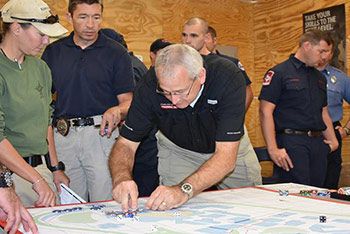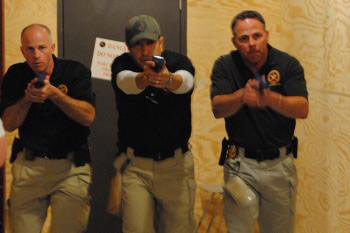Contact Us
To provide feedback on the Community Policing Dispatch, e-mail the editorial board at CPDispatch@usdoj.gov.
To obtain details on COPS Office programs, publications, and resources, contact the COPS Office Response Center at 800-421-6770 or AskCopsRC@usdoj.gov

U.S. Department of Justice
Office of Community Oriented Policing Services
Washington, DC 20530
In recent years, our nation has experienced an increasing number of shooting attacks and mass casualty events. These incidents have occurred in random locations across the country – Newtown, Connecticut, Orlando, Florida, Las Vegas, Nevada, and Parkland, Florida among them. According to the FBI, there were 220 active shooting incidents between 2000 and 2016. In these incidents, 661 individuals lost their lives and 825 were wounded. 1
These mass casualty events are almost impossible to predict and can occur at any place a nd at any time. Therefore, it is critical that all first responders – including local, county, state and federal law enforcement, emergency medical services (EMS), fire – be prepared to respond safely and effectively to minimize loss of life and injury. But, these responders often have overlapping roles and responsibilities, as well as different communications systems, policies and protocols. In an extremely volatile situation, lack of coordination and communication can cause serious problems.
Build Relationships Before They Are Needed
Establishing relationships well before an incident occurs is critical to any successful response. For this reason, the COPS Office is funding Texas State University Advanced Law Enforcement Rapid Response Training (ALERRT) program’s Active Attack Integrated Response (AAIR) training. As a key component of the ALERRT program, AAIR is a scenario-based training program developed to teach police, fire, and EMS personnel how to work together effectively in an integrated command structure.
Thanks to funding provided by the COPS Office in 2017, more than 15,000 individuals have completed AAIR training. These individuals are located in 20 U.S. regions that usually include more than one police department. With the continued support from the COPS Office, AAIR will deliver multiple levels of integrated response training to thousands more individuals in the coming year.
Work Together to Stop the Killing, Stop the Dying, and Start the Recovery
 The overarching goal of AIRR training is to prepare all stakeholders, including first responders, dispatchers, communications staff and traffic control experts, to respond seamlessly to mass casualty events. To achieve this, each segment of the training will bring individuals from these professions together to role-play realistic scenarios related to the three basic goals of any response: to stop the killing, stop the dying, and start the recovery.
The overarching goal of AIRR training is to prepare all stakeholders, including first responders, dispatchers, communications staff and traffic control experts, to respond seamlessly to mass casualty events. To achieve this, each segment of the training will bring individuals from these professions together to role-play realistic scenarios related to the three basic goals of any response: to stop the killing, stop the dying, and start the recovery.
We know from the experiences in cities such as Boston and Orlando that a well-coordinated, multidisciplinary response makes the difference between order and chaos. To be capable of this in the midst of such events, responders must already know how to work together under conditions that simulate the complexity, chaos, and stress of an attack. AAIR training not only provides experiential learning, but by bringing people together, it encourages responders to build relationships and trust.
Establish a Unified Command Structure
One of the first lessons that participants learn in AIRR training is the importance of establishing a unified command structure. This is critical because over-convergence is a common challenge at the beginning of a violent attack. When hundreds of first responders pour into the area, the officer in command must immediately turn them into deployable resources rather than randomly operating units. This requires coordination among police, fire, and EMS.
Because these are three different disciplines, each with their own culture and chain of command, coordinating their efforts can be problematic. And, if county, state or federal law enforcement is added to the mix, establishing a unified command system may be even more difficult, resulting in confusion and miscommunication. The AAIR training program brings representatives from diverse response and stakeholder groups together to understand each other’s roles and prepare to work together in a wide variety of challenging situations.
Reinforce Learning in Realistic Scenarios
 AIRR training, which lasts two days, takes responders through their responsibilities while teaching them necessary tactical skills. The students are also taught to coordinate into an integrated command structure, beginning with the first officer on the scene. In the training, students are taught how to identify open danger areas and the need for an exigent approach, how to evaluate a threshold as a solo responder, and how to coordinate link-up with follow-on responders.
AIRR training, which lasts two days, takes responders through their responsibilities while teaching them necessary tactical skills. The students are also taught to coordinate into an integrated command structure, beginning with the first officer on the scene. In the training, students are taught how to identify open danger areas and the need for an exigent approach, how to evaluate a threshold as a solo responder, and how to coordinate link-up with follow-on responders.
This scenario-based training also includes a walk through of a response to an uncomplicated active shooter attack. Following this, students participate in a series of realistic scenarios based on real world events, designed to highlight key decision-making points and give participants opportunities to practice critical decision-making skills. Participants are also taught emergency medical skills – such as how to apply a tourniquet and stop the bleeding that leads to so many losses of life – as well as how to operate in a Rescue Task Force (RTF).
Evaluate Outcomes and Test Critical Thinking Skills
Each of the realistic training scenarios is followed by a debriefing session, encouraging participants to discuss what went well, what didn’t, and how their performance could be improved. Students then participate in progressively more complex scenarios designed to reinforce the skills that they have learned and to test their critical thinking abilities. Additional debriefs are conducted immediately following each exercise.
To ensure the consistency as well as quality of the program, AAIR provides regional train-the-trainer classes, most hosted on- site at local police departments, but some classes are also available at ALERRT’s San Marcos Texas facility. To mentor the newly certified trainers, experienced instructors co-teach and audit their classes.
Support Nationwide Training for Nationwide Readiness
Unfortunately, the question before us is not if another attack will occur – but when and where. All first responders must prepare for the possibility that it could happen in their community by conducting integrated exercises to maintain readiness and ensure cooperation. Even those agencies who have gone through some form of training can benefit from the AAIR training program. In addition to providing them with new ideas which could improve their training, it would provide a platform to test the system that they have developed and reinforce what their participants have already learned.
AAIR is in the forefront of the effort to standardize and reinforce the coordinated response that can save lives and reduce injuries of both victims and responders, and the COPS Office is proud to lend its support to this effort. To learn more about the AAIR course, visit the COPS Office online training portal at https://copstrainingportal.org/alerrt/.
Faye Elkins
Senior Technical Writer
References:
1. “Quick Look: 250 Active Shooter Incidents in the United States From 2000 to 2017,” FBI, accessed June 5, 2018, https://www.fbi.gov/about/partnerships/office-of-partner-engagement/active-shooter-incidents-graphics
Subscribe to Email Updates
To sign up for monthly updates or to access your subscriber preferences, please enter your email address in the Subscribe box.






